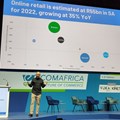Marketing & Media trends
Industry trends
BizTrends Sponsors
Trending
#EcomAfrica: How the rise of paytech is reshaping cross-border payments

This was one of the emergent trends in fintech highlighted at EcomAfrica 2023 held at the CTICC earlier this month.
Last year alone, 57% of online shoppers made cross-border purchases, with an increasing move towards the rise of super apps that provide a single entry point and user experience to access many services consumers expect – under one roof.
From social interactions and shopping to delivery and ride hailing, banking and investing to budgeting and payments, super apps combine an ever-expanding range of services in a singular immersive experience.
With Elon Musk's plan to turn Twitter into a super app, global e-commerce's direct growth looks set to remain robust.
"In 2018 the total e-commerce spend was in the region of $3.7tn, and there has since been significant double-digit growth which has seen it rise to $6tn in 2022," says Arun Varughese, head of tech, media and telecom at Rand Merchant Bank. He was a keynote speaker at EcomAfrica 2023 and based his insights on the The Global Payments Report.
Varughese went on to say that, in spite of the double-digit growth linked to the Covid pandemic period when many people were shopping online, we are still expected to see a strong year on year growth in global e-commerce revenue of around 9%. This will reach €660bn this year, and its direct growth will hit $8.5tn in 2026.
Argentina will be leading the pack with 21% projected growth; both Nigeria and South Africa will each have a projected growth of 16%.
Digital wallets on the rise
No surprises, mobile commerce represented 36% of global e-commerce transaction value last year, with transactions being led by digital wallets.
"Most of us have smartphones and prefer to use or transact by means of our smartphones. Digital wallets continue to be the preferred payment method across all channels. They account for 32% of point-of-sale spending, and close to 50% of all e-commerce transactions in 2022. This is followed by the credit card, and account-to-account (A2A), which is driven by real-time payment schemes," says Varughese.
“Digital wallets are easy to use. They are safe due to tokenisation which allows for multiple funding sources; you can move monies from your bank account, credit-card account, savings account, and cheque account to your wallet."
Next-level solutions
Strong positive growth in e-wallets is projected all the way through to 2026, and as a result, innovation and competition in e-wallet development is intense. Take, for example, these payment solutions:
- A2A was originally built for B2B and peer to peer transactions, but it's been gaining traction enabling person-to-business transactions, so much so that the transaction value reached $525m last year. This is up 13% from 2021. A2A uses normal payment rails and so there's no need to charge fees. This means lower costs. The funds are available immediately which is a plus for merchants.
- Techlink is used via WhatsApp.
- Pix was launched by the Central Bank of Brazil, largely as a means to get the unbanked population to the banking platform and to promote a low-cost digital payment method. Almost a quarter of all transactions last year was done by means of the Pix payment method and significant growth is projected.
- In South Africa we launched PayShap driven by the South African Reserve Bank in partnership with BankservAfrica. PayShap was launched based on the success story of Pix.
- Similarly in India there's a payment method called UPI. UPI is also driven by the Payments Council of India together with the Central Reserve Bank. 14% significant growth in the use of UPI is expected in the near future.
- The Ha payment is not as popular. China has got a very low adoption rate of around 2%.
- Super apps are definitely disrupting the payment value chains. Super app is an umbrella term to describe combinations of popular digital services all housed within a single app.
A super app provides a single entry point and user experience to access many services consumers expect – under one roof. Amazon, Alibaba, Joomla are ecosystems that have payment systems embedded within the marketplace itself. They have proven popular in Asia, Latin America and Africa, and look set to gain further traction because consumers in these countries own smartphones that don't have the capacity to manage 40 to 50 separate apps.
- Consumer demand for credit remains strong and Buy Now Pay Later (BNPL) continues to evolve. It started off in the mid-2010s with companies offering the consumer the option to pay over a period of time, say three months, at very low or no interest. The payments company would offer the sale to the merchants immediately.
There has been case adoption and explosive growth. Back in 2020/21 BNPL showed the highest growth. Fast-forward to last year, and growth was stagnant overall due to higher inflation and central banks increasing interest rates.
Despite this, nations such as Germany saw their BNPL transactions go through the roof last year - 22% of all their transactions went through BNPL. Businesses should know we are living in a very dynamic environment and that we expect 100% growth in BNPL in 2026.
Taobao Maker Festival is back, free exhibitions in 10 cities will allow the public to fully enjoy the diverse "Taobao experience". 3 main venues, namely "Technology", "Wonder" and "Trends" will also be live-streamed on Taobao Live. #TaobaoMakerFestival #innovation pic.twitter.com/xTjOh2duy0
— Alibaba Group (@AlibabaGroup) April 26, 2023
Localisation the key to growth
Despite the increased adoption of paytech, there is room for improvement, says Varughese.
"There are still some issues with cross-border shopping payments. Forty percent of deliveries took longer than expected; 58% of the price was in foreign currency and 37% bought a poor quality product. This is important because there are still so many ways to get it wrong on trust, transparency and making the experience simple and convenient for the consumer."
“Building trust, starts with localising the customer experience," says Varughese. "Sixty to sixty two percent of users demand a local language and currency on their online platforms. Merchants should always launch their platform in the correct local language as well as currency payment methods, and look to make local products available."
Seamless checkout experience
Paytech allows for a super consumer checkout experience. It raises competitive stakes for brand experiences everywhere, and provides diverse functionality.
As a global phenomenon e-wallets are shaping a new future of commerce as contactless payments are on the rise.
"While the statistics coming to the fore represent global figures, it is also important to note that there are many countries showing double-digit growth. US reflects a projected growth at 14%, UK 18% and Denmark 21%," says Varughese. "Global e-commerce continues to grow in all regions and these markets are presenting attractive growth opportunities for merchants and for paytech development."
This continues to redefine how consumers shop, pay and connect with brands around the world.
















